Tuesday, February 12, 2008
The Moment It Clicks
I was going to say "Go right now and buy 'The Moment It Clicks' by Joe MacNally. Now. Right now right now." but you can't. It's out of stock at Amazon. Let me just add my voice to the chorus that this is an amazing amazing amazing book that you should have.
In any case, you should stick it in your shopping cart until they restock.
In any case, you should stick it in your shopping cart until they restock.
Monday, February 11, 2008
After-Action Report: Bogen Cafe with Steven Katzman
This past Saturday, February 9, I went to my first ever photography workshop. It was the Bogen Café with Steven Katzman event for Seattle, presented in partnership with Glazer's Camera. The speaker was Steven Katzman, whom I thought was a really nice guy and an excellent speaker.
The event started at 10:00, with Steven giving a short presentation about some of the lessons he learned over his career about how to be a better, or at least good, photographer. I took my notebook with me so I could write all this down, but the room lights had two settings ("off" and "OMFG that's bright") so I couldn't see well enough to record any thoughts during the presentation. I got the big point, which was to be empathetic and connected with your subjects but don't let that stop you from getting the picture.
The presentation included many shots from his new book, "Face of Forgiveness," as well as other photos from his catalog. He didn't lecture about any particular photo in terms of f-stop or exposure or even lighting setup. He mostly talked about the importance of feeling something, and connecting, and with telling the story. He showed photos from New Town and talked about how he got them, how the people in New Town and he came together, and how they were still affecting his life.
After the lecture portion of the program was over, the folks from Bogen and Glazer's led us back into a large studio space where they had set up three separate workshop areas with some serious high-dollar lighting gear and some models. Steven talked about the lights in general terms and named the equipment, but he wanted to talk about how to shoot a well-exposed shot with the gear, which quite frankly was far more interesting to me. His lesson here got me to use the histogram display on my camera far more than I've ever used it before, and I'm already applying the lesson there to the shots I'm taking at home. So yay! I got my money's worth! While we were ogling the lighting gear, and many of us were trying not to ogle the models, the Glazer's folk set up a fourth workshop area back in the lecture room with two more models.
Then they cut us loose and let us wander around taking turns being the photog at each station. All of the stations were set up with PocketWizards, so when it was your turn you just slapped the PW transmitter into your hot-shoe and off you went. Since I'd already shot a few hundred frames with my Cactus triggers, this was dead simple but a few other students hadn't seen wireless triggers and/or off-camera lighting, so the pace of the students through the process was quite uneven.
 So here's station #1. You can see the ginormous softbox at camera right, and the edge of a big piece of white cardboard at camera left. The backdrop is just a cloth slung over a backdrop holder, and the models are members of the local Roller Derby team. The middle girl is holding a 90% white target so you can set the white balance in post-processing.
So here's station #1. You can see the ginormous softbox at camera right, and the edge of a big piece of white cardboard at camera left. The backdrop is just a cloth slung over a backdrop holder, and the models are members of the local Roller Derby team. The middle girl is holding a 90% white target so you can set the white balance in post-processing.
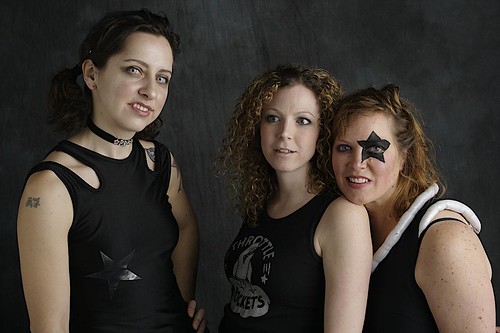 Here's what they look like when I was the photog and the light comes from that lovely lovely softbox and reflector instead of those nasty fluorescents. I managed to get each of the three girls with apparently completely different direction, so I apparently have a talent for something even if it isn't photography.
Here's what they look like when I was the photog and the light comes from that lovely lovely softbox and reflector instead of those nasty fluorescents. I managed to get each of the three girls with apparently completely different direction, so I apparently have a talent for something even if it isn't photography.
 Station #2 had a single umbrella above eye-level at camera right and a second strobe about seven feet up at camera left. There was also a silver reflector in a frame handy, but I didn't use it (I'll come back to that shortly).
Station #2 had a single umbrella above eye-level at camera right and a second strobe about seven feet up at camera left. There was also a silver reflector in a frame handy, but I didn't use it (I'll come back to that shortly).
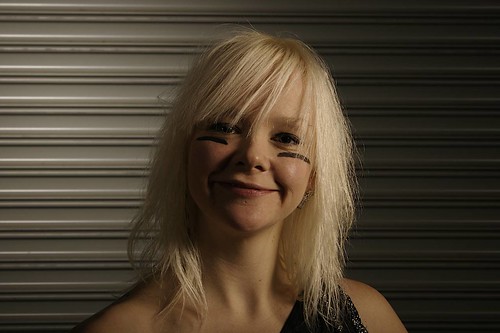 This was "Dirty 007." She tried so hard to look all tough and edgy. All of the roller derby girls tried very very hard to look tough and edgy. Maybe it's just that I'm old now or something, but they all looked as cute as kittens and about as ferocious. They were great. Anyway, I liked this shot because I got the specular highlight on the rollup door behind her head where I wanted it for a nice light-shadow duality thing.
This was "Dirty 007." She tried so hard to look all tough and edgy. All of the roller derby girls tried very very hard to look tough and edgy. Maybe it's just that I'm old now or something, but they all looked as cute as kittens and about as ferocious. They were great. Anyway, I liked this shot because I got the specular highlight on the rollup door behind her head where I wanted it for a nice light-shadow duality thing.
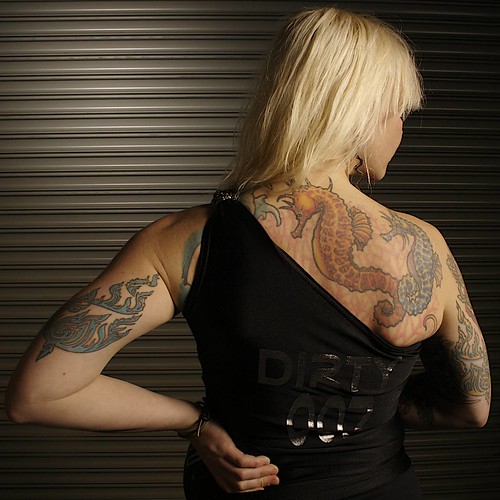 I also got her to turn around so I could shoot her tattoos. She was all inked up and stuff, but still was just cute as a bug in a rug. My guess is that she's roughly the same age as the jeans I was wearing because I am just that much of an old curmudgeonly bastard.
I also got her to turn around so I could shoot her tattoos. She was all inked up and stuff, but still was just cute as a bug in a rug. My guess is that she's roughly the same age as the jeans I was wearing because I am just that much of an old curmudgeonly bastard.
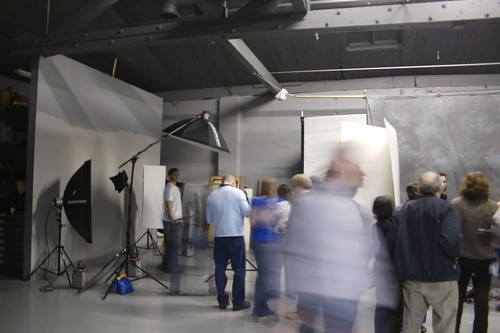 Station #3 had one lightbox directly overhead, a white reflector angled up from beneath, and two lightstrips firing from behind the model angled in towards the center. In the setup shot, you can see the overhead lightbox and the two light strips (one facing you and one in profile). The reflector is there too, but it's in a frame and you're viewing it edge-on.
Station #3 had one lightbox directly overhead, a white reflector angled up from beneath, and two lightstrips firing from behind the model angled in towards the center. In the setup shot, you can see the overhead lightbox and the two light strips (one facing you and one in profile). The reflector is there too, but it's in a frame and you're viewing it edge-on.
I did, however, have a really good time. I learned several things, some positive and some negative. I've been able to apply those lessons in my other shooting around the house, and I even think it's helping. In short, this was well worth the measly $25 I paid for the class.
I've got more frames up on my Flickr page, by the way, in case you aren't already bored beyond belief.
The event started at 10:00, with Steven giving a short presentation about some of the lessons he learned over his career about how to be a better, or at least good, photographer. I took my notebook with me so I could write all this down, but the room lights had two settings ("off" and "OMFG that's bright") so I couldn't see well enough to record any thoughts during the presentation. I got the big point, which was to be empathetic and connected with your subjects but don't let that stop you from getting the picture.
The presentation included many shots from his new book, "Face of Forgiveness," as well as other photos from his catalog. He didn't lecture about any particular photo in terms of f-stop or exposure or even lighting setup. He mostly talked about the importance of feeling something, and connecting, and with telling the story. He showed photos from New Town and talked about how he got them, how the people in New Town and he came together, and how they were still affecting his life.
After the lecture portion of the program was over, the folks from Bogen and Glazer's led us back into a large studio space where they had set up three separate workshop areas with some serious high-dollar lighting gear and some models. Steven talked about the lights in general terms and named the equipment, but he wanted to talk about how to shoot a well-exposed shot with the gear, which quite frankly was far more interesting to me. His lesson here got me to use the histogram display on my camera far more than I've ever used it before, and I'm already applying the lesson there to the shots I'm taking at home. So yay! I got my money's worth! While we were ogling the lighting gear, and many of us were trying not to ogle the models, the Glazer's folk set up a fourth workshop area back in the lecture room with two more models.
Then they cut us loose and let us wander around taking turns being the photog at each station. All of the stations were set up with PocketWizards, so when it was your turn you just slapped the PW transmitter into your hot-shoe and off you went. Since I'd already shot a few hundred frames with my Cactus triggers, this was dead simple but a few other students hadn't seen wireless triggers and/or off-camera lighting, so the pace of the students through the process was quite uneven.
 So here's station #1. You can see the ginormous softbox at camera right, and the edge of a big piece of white cardboard at camera left. The backdrop is just a cloth slung over a backdrop holder, and the models are members of the local Roller Derby team. The middle girl is holding a 90% white target so you can set the white balance in post-processing.
So here's station #1. You can see the ginormous softbox at camera right, and the edge of a big piece of white cardboard at camera left. The backdrop is just a cloth slung over a backdrop holder, and the models are members of the local Roller Derby team. The middle girl is holding a 90% white target so you can set the white balance in post-processing. Here's what they look like when I was the photog and the light comes from that lovely lovely softbox and reflector instead of those nasty fluorescents. I managed to get each of the three girls with apparently completely different direction, so I apparently have a talent for something even if it isn't photography.
Here's what they look like when I was the photog and the light comes from that lovely lovely softbox and reflector instead of those nasty fluorescents. I managed to get each of the three girls with apparently completely different direction, so I apparently have a talent for something even if it isn't photography. Station #2 had a single umbrella above eye-level at camera right and a second strobe about seven feet up at camera left. There was also a silver reflector in a frame handy, but I didn't use it (I'll come back to that shortly).
Station #2 had a single umbrella above eye-level at camera right and a second strobe about seven feet up at camera left. There was also a silver reflector in a frame handy, but I didn't use it (I'll come back to that shortly). This was "Dirty 007." She tried so hard to look all tough and edgy. All of the roller derby girls tried very very hard to look tough and edgy. Maybe it's just that I'm old now or something, but they all looked as cute as kittens and about as ferocious. They were great. Anyway, I liked this shot because I got the specular highlight on the rollup door behind her head where I wanted it for a nice light-shadow duality thing.
This was "Dirty 007." She tried so hard to look all tough and edgy. All of the roller derby girls tried very very hard to look tough and edgy. Maybe it's just that I'm old now or something, but they all looked as cute as kittens and about as ferocious. They were great. Anyway, I liked this shot because I got the specular highlight on the rollup door behind her head where I wanted it for a nice light-shadow duality thing. I also got her to turn around so I could shoot her tattoos. She was all inked up and stuff, but still was just cute as a bug in a rug. My guess is that she's roughly the same age as the jeans I was wearing because I am just that much of an old curmudgeonly bastard.
I also got her to turn around so I could shoot her tattoos. She was all inked up and stuff, but still was just cute as a bug in a rug. My guess is that she's roughly the same age as the jeans I was wearing because I am just that much of an old curmudgeonly bastard. Station #3 had one lightbox directly overhead, a white reflector angled up from beneath, and two lightstrips firing from behind the model angled in towards the center. In the setup shot, you can see the overhead lightbox and the two light strips (one facing you and one in profile). The reflector is there too, but it's in a frame and you're viewing it edge-on.
Station #3 had one lightbox directly overhead, a white reflector angled up from beneath, and two lightstrips firing from behind the model angled in towards the center. In the setup shot, you can see the overhead lightbox and the two light strips (one facing you and one in profile). The reflector is there too, but it's in a frame and you're viewing it edge-on. So this is what Marcus looks like when the lights fire. He looks great, and it's because the lighting setup was great so that I pretty much just had to be there to press the shutter release.
So this is what Marcus looks like when the lights fire. He looks great, and it's because the lighting setup was great so that I pretty much just had to be there to press the shutter release.
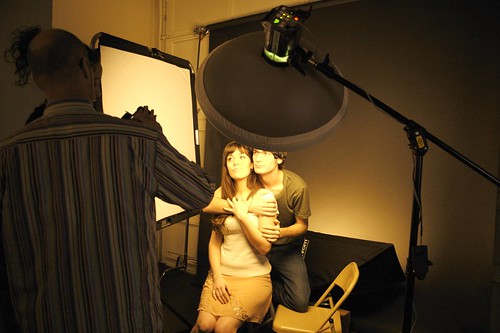 Station #4 had a beauty dish high at camera right, a white reflector at camera left, and a softbox firing into the backdrop. I forget the lighting ratio between main and backlight mostly because I failed to write it down in my notebook.
Station #4 had a beauty dish high at camera right, a white reflector at camera left, and a softbox firing into the backdrop. I forget the lighting ratio between main and backlight mostly because I failed to write it down in my notebook.
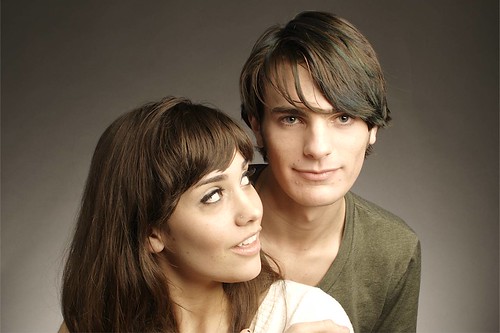 Megan and Lewis. These people are clearly aliens because no normal humans can be that gorgeous.
Megan and Lewis. These people are clearly aliens because no normal humans can be that gorgeous.
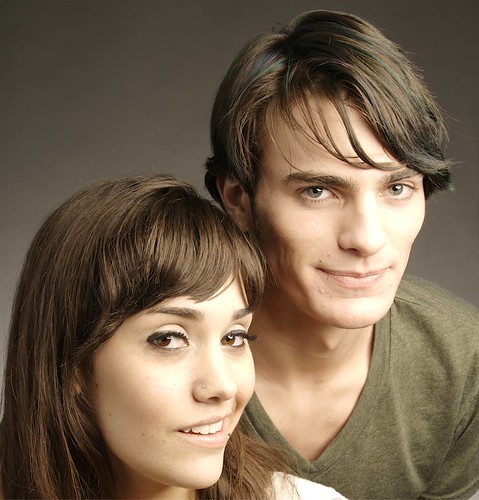 Don't believe me? Look at them. Tell me you're that good-looking. G'wan. That's what I thought you said.
Don't believe me? Look at them. Tell me you're that good-looking. G'wan. That's what I thought you said.
So what did I learn?
- Be the director I was the photographer, certainly, but I provided almost no direction to the models. Consequently, the pictures I got were basically whatever they felt like doing. This might have been great, or it might have been slack, but in any case I wasn't controlling the outcome but was being swept along towards whatever happened. This is not the way to get good results, and I'll have to work harder at getting outside of the aim-fire-chimp mode next time.
- Connect with the models This is espeically ironic since this was one of the lessons that Steven was trying to get across in the lecture. I was taking photos, but I was treating the models as if they were still life objects instead of people. I didn't even get the names of most of the models. Next time I resolve to make sure I introduce myself, get their names and email addresses, and write them down. I'll also try to actually talk to them as people, but my small talk skills are somewhat limited so I don't know how well that part will work.
- Do something different Part of this is just the novelty of having models that aren't my children, but I just stood there right in front of them pushing the button on all of these shots. I didn't stand on anything, even though there were chairs and ladders to be had. I didn't squat down. I didn't sit down. I didn't really do anything except stand there like a spectator.
The other part of this ties back to #1 above: I didn't direct the lighting either. I didn't move a single light from where it was when I walked up to the station. I didn't use any reflectors that the Glazer's folk hadn't already set in place. I didn't make the lights brighter or dimmer. I didn't do any of that.
I did, however, have a really good time. I learned several things, some positive and some negative. I've been able to apply those lessons in my other shooting around the house, and I even think it's helping. In short, this was well worth the measly $25 I paid for the class.
I've got more frames up on my Flickr page, by the way, in case you aren't already bored beyond belief.
Subscribe to:
Comments (Atom)